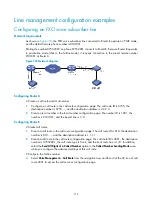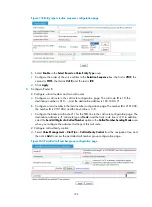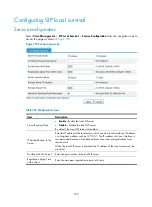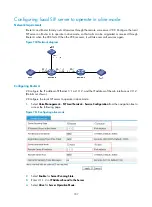
728
Configuring SIP local survival
IP phones have been deployed throughout the headquarters and branches of many enterprises and
organizations. Typically, a voice server is deployed at the headquarters to control calls originated by IP
phones at branches.
The local survival feature enables the voice router at a branch to automatically detect the reachability to
the headquarter voice server, and process calls originated by attached IP phones when the headquarters
voice server is unreachable. The headquarters voice server will take over call services from the branch
voice router when the failure is removed.
shows a typical network diagram for the local survival feature.
Figure 749
Network diagram for the local survival feature
The following describes the local survival feature in detail:
1.
When the WAN link from a branch to the headquarters is normal, all IP phones at the branch are
registered with the headquarters voice server and the headquarters voice server processes calls
originated by branch IP phones.
2.
When the WAN link to the headquarters or the primary server fails:
The branch voice router can accept registrations from its attached IP phones.
The branch voice router ensures the normal call services between its IP phones, between its IP
phones and FXS interfaces, and between its FXS interfaces.
IP phone users at the branch can place or receive PSTN calls through FXS interfaces on the
voice router.
3.
When the WAN link or the primary server recovers, the branch voice router rejects registrations
from IP phones and the headquarters voice server takes over call processing.
WAN
Server
Headquarters
Branch B
PSTN
Branch A
Branch C
Summary of Contents for MSR SERIES
Page 17: ...xv Documents 835 Websites 835 Conventions 836 Index 838 ...
Page 20: ...3 Figure 3 Initial page of the Web interface ...
Page 42: ...25 Figure 13 Firefox Web browser setting ...
Page 59: ...42 Figure 27 Checking the basic service configuration ...
Page 73: ...56 Figure 35 Sample interface statistics ...
Page 156: ...139 Figure 139 Rebooting the 3G modem ...
Page 168: ...151 Figure 152 Configuring Web server 2 ...
Page 174: ...157 Figure 158 Configure the URL filtering function ...
Page 242: ...225 Figure 233 Enabling the DHCP client on interface Ethernet 0 1 ...
Page 247: ...230 Figure 236 The page for configuring an advanced IPv4 ACL ...
Page 255: ...238 Figure 241 Advanced limit setting ...
Page 298: ...281 e Click Apply 2 Configure Router B in the same way Router A is configured ...
Page 400: ...383 Figure 387 Verifying the configuration ...
Page 405: ...388 ...
Page 523: ...506 Figure 530 Ping configuration page ...
Page 775: ...758 Figure 785 Configuring a jump node ...
















































